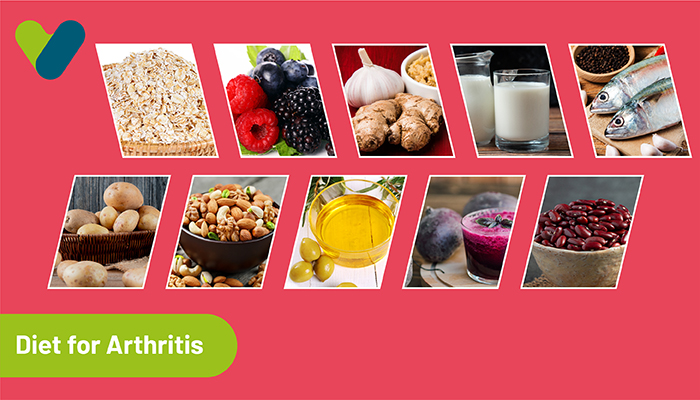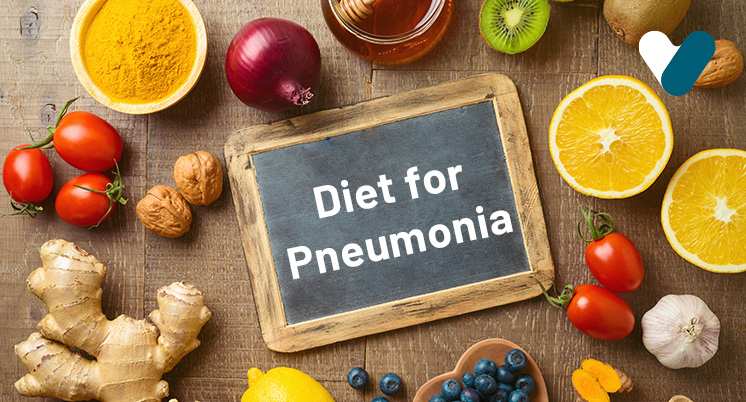Diet Chart For Arthritis
Maintaining a healthy diet helps you cope with diseases like arthritis. Although no miracle diet can cure the condition, there are specific food items that help with reducing inflammation and joint pain, which are the prominent
symptoms of arthritis. You should also avoid certain food products that aggravate the symptoms. Following a strict arthritis diet regimen supports the treatment plan and helps with recovery.
Besides reducing the symptoms, the aim of an arthritis diet is to maintain healthy body weight. If you are obese, there is an extra load on the joints in your spine, hips, knees, and feet. As a result, arthritis symptoms worsen. Doctors recommend exercising for the same. Regular exercise and diet together can help ease your symptoms and pave the way for weight management. Also, your doctor may recommend you consult a nutritionist for proper guidance about arthritis treatment food to include and arthritis food to avoid in your diet. Seeking advice helps balance the intake and avoid items that negatively react with your medication.
Foods to Eat During Arthritis Treatment
Some food items you can consider adding to your diet while coping with arthritis include the following.
-
-
- Whole Grains
Whole grains are natural sources of nutrients and fibre. Consuming three to six ounces of whole-wheat flour, oatmeal, brown rice, quinoa, etc., helps fulfil your daily requirements. While trying out the varieties, you should choose wisely, as whole grains contain gluten, which, in turn, may cause inflammation – a common arthritis symptom. You can choose a combination of healthy whole grains that are also low in gluten after consulting your doctor or nutritionist.
-
-
- Beans
Loaded with fibre and phytonutrients, beans help lower the C-reactive protein (CRP), which increases inflammation. They are also an excellent source of protein, packed in 15 grams per cup which improves muscle health. You can include at least one cup of small red beans, black beans, or kidney beans in your arthritis diet to make the most of the nutritional benefits of these healthy food products.
-
-
- Nuts
Almonds, walnuts, pistachios, peanuts, pecans, and other nuts are packed with several healthy nutrients including fibre, magnesium, calcium, zinc, Omega-3, and vitamin E. These nutrients contain anti-inflammatory properties that provide a sense of relief from arthritis pain while also offering an extra boost of protein. Despite the high fat and cholesterol content, nuts promote weight loss as they contain satiated fat.
-
-
- Fruits
Fruits are rich in antioxidants, which help in fighting inflammation. A variety of berries, especially strawberries, cranberries, raspberries, and blackberries offer nutrients to manage arthritis symptoms. You can also consider citrus fruits like lime, grapefruit, and oranges for vitamin C, which helps in maintaining healthy joints. You can have them raw, juice them, or have dried fruits. However, it is best to avoid the frozen or canned fruits, packed with artificial preservatives.
-
-
- Vegetables
Like fruits, various vegetables have anti-inflammatory properties. They are also rich in nutrients and antioxidants that protect you against cell damage in joints. The darker the colour of vegetables, the more antioxidants they contain. Some of them include spinach, broccoli, collard greens, beetroot, etc. You can stir-fry or steam them instead of boiling them to retain the nutrients.
-
-
- Fatty Fish
Fatty fish varieties are high in omega-3 fatty acids, which have anti-inflammatory effects, making them ideal arthritis treatment foods. They also contain vitamin D, which assists the body in absorbing calcium and building strong bones. Such strength helps in controlling arthritis pain. Some fish varieties rich in fatty acids are sardines, mackerel, pomfret, tuna, prawns, etc.
-
-
- Dairy Products
Dairy items such as milk, yoghurt, and cheese help in building bone strength due to the high calcium and vitamin D content. They also contain protein that builds muscle. Such effects relieve arthritis symptoms. If you are lactose intolerant, you can try dairy alternatives like soya, coconut, oats, and chickpea milk for protein. You can also choose the variants with added calcium for bone strength.
-
-
- Starchy Foods
Starchy foods such as potatoes, cereals, rice, pasta, etc., are high in carbohydrates. They act as energy sources for the body. Additionally, they are rich in fibre, which improves digestion and assists with maintaining healthy body weight. However, you should select starchy foods carefully and avoid added salt or sugar that aggravates arthritis symptoms.
-
-
- Ginger and Garlic
Staples in most Indian meals, ginger and garlic are more than just ingredients for flavour. They are known to ease the symptoms of arthritis. Taking ginger supplements is good for reducing inflammation and pain in the joints. Adding garlic to your diet will give you a similar anti-inflammatory effect. Ginger and garlic also assist with limiting arthritis progression.
-
-
- Food Cooked in Olive Oil
Like most arthritis treatment food, Olive oil contains anti-inflammatory properties, which has a favourable effect on arthritis symptoms. Extra virgin olive oil contains an active compound like oleuropein aglycone (OleA) that promotes the process of clearing damaged cells from the body called autophagy. Other compounds in olive oil reduce the production of pro-inflammatory substances in joints.
Food to Avoid & Beverages to Dismiss During Arthritis Treatment
Some of the worst foods for arthritis patients, that they should avoid in their diet include the following.
-
-
- Sugar
Excess sugar intake is bad for coping with any disease, including arthritis. Naturally occurring sugar in fruits and milk has no negative impact on health. But artificial, refined sugar added to candy, soda, ice cream, and other processed foods increases cytokines. These inflammatory proteins worsen rheumatoid arthritis. They contribute to swelling, pain, and stiffness in the joints.
-
-
- Saturated & Trans-Fat-Containing Products
Fatty acids present in olive oil, nuts, fish, avocados, etc., protect your health and maintain organ function. But trans-fat-containing products like fried snacks, fast foods, and processed edibles cause inflammation. Saturated fat is equally bad as it deposits in the cartilage, which promotes cartilage breakdown and joint damage.
-
-
- Red Meat
Red meat contains high levels of saturated fat, which leads to inflammation and increases cholesterol in the body. In addition, when grilled, broiled, roasted, and fried, red meat produces advanced glycation end products (AGEs) that stimulate inflammation. Hence, red meat is one of the worst foods for arthritis.
-
-
- Refined Carbohydrates
Refined carbohydrates undergo processing which removes fibre and nutrients beneficial for energy and they make you feel full. They also have a high glycaemic index that raises blood sugar levels and increases inflammation. Another side effect of consuming refined carbs is an increased risk of obesity which makes it hard to recover from arthritis.
-
-
- Gluten-Containing Foods
Gluten is a protein found in grains like wheat, barley and rye. If you have celiac disease, a condition that damages your small intestine, you should completely avoid gluten. Gluten can leak into your bloodstream and inflame your gut as well as joints. Even without celiac disease, a gluten-free diet is good for managing arthritis symptoms.
-
-
- Processed Snacks
Among the worst foods for arthritis patients are processed items, especially deep fried or flour-filled snacks. Stirring clear of them is important to avoid monosodium glutamate, aspartame, and other chemicals linked with inflammation. Besides swelling, such food items also weaken your body's defence mechanism, which makes it challenging to recover from arthritis.
-
-
- Food High in Purines
Purines are the main reason for the formation of uric acid crystals in the body. When they build up in the bloodstream, they can lodge in the joint fluid and cause pain and swelling. The result is a type of arthritis condition called gout, which affects the joint in the big toe. You can avoid this disease from progressing by limiting your intake of organ meats, seafood, and other high-purine foods.
-
-
- High-Fat Dairy
While dairy has beneficial nutrients and calcium that enhance bone and muscle strength, certain dairy products are high in fat. Some examples include heavy cream, full-fat cheese, whole milk, etc. They also contain a protein called casein, which triggers inflammation in joints. Therefore, including the right kind of dairy products is important in your arthritis diet.


